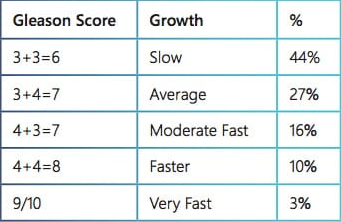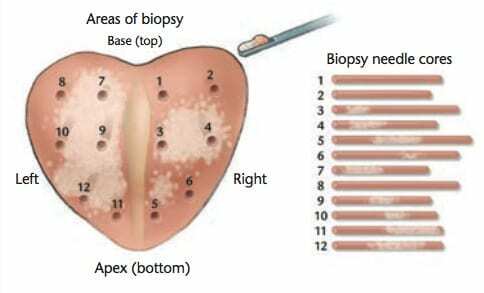The tissue removed during a prostate biopsy is sent to a pathologist for further analysis and testing. Pathologists are doctors who perform various tests on the tissue to see if the cells are cancerous, precancerous, or normal. Your pathologist will then summarize the results of the tests and their findings in a prostate biopsy pathology report that details the results and outlines the findings. This report is a critical part of determining a treatment plan for each patient.
The report discusses any abnormal, atypical, or cancerous cells that were found. Pathology reports can differ on some of the specific information they contain based on each pathologist. Still, there are a few key components that you may want to review.
Gross Description - this is the pathologist’s initial study of the tissues without using a microscope.
Microscopic Description - this portion of the report is also a visual study of the tissue. This section covers what the pathologist saw when the tissue was under magnification.
Gleason Score - this section outlines a specific method of understanding how fast cancer may grow. That results in a grade.
Cell structure - your pathologist will also classify cancer based on the cell structure. This section is typically broken into three grades and identifies how well cancer cells are differentiated from each other. This can result in determining the type of prostate cancer that’s present.
While it is likely that your medical team will have copies of your report, you should request your own. Take your time in reviewing the report and ask questions about parts that are not clear.

When evaluating your particular case of prostate cancer, there are three major factors we first consider:
1) Gleason Score
2) PSA
3) Stage
While a pathologist may not include discussion about PSA or Stage in the pathology report, these factors are critical to identify an appropriate treatment plan. Work with your doctor to understand each of these factors. This helps to recognize what your doctor is looking for, and what certain values mean.
The Gleason Score is considered the most important factor because it shows the rate at which cancer is growing. It is one factor in your prostate cancer treatment planning that is included in the pathology report.
The Gleason Score system was developed by Dr. Don Gleason based upon his study of prostate biopsies under the microscope. The table below shows five Gleason Score categories with the percent of men that we have seen with these scores in our practice in the past few years.

A 12-needle biopsy is the standard procedure for prostate biopsy. The biopsy is then sent to a pathologist who looks at the specimens under the microscope. Based upon their findings, they determine your Gleason score, write the biopsy report, and send it to the urologist.

Biopsy samples are not always the most accurate measure of your cancer. There are two main factors that cause the potential for inaccurate findings. First, when a 12-needle biopsy is performed, only a tiny amount of prostate tissue is removed. Thus, a needle could hit a large area of the tumor and show a Gleason Score of 4+3. However, it is possible that a small area of Gleason 4+4=8 was missed. We have found this issue by comparing biopsy Gleason Scores to men who later had a Radical Prostatectomy in which the entire prostate is studied. Fortunately, this is uncommon with the 12-needle biopsy.
The second reason for an inaccurate finding and subsequent Gleason Score can depend on the skill and experience of the pathologist. Pathologists may differ in the interpretation of their findings resulting in varied Gleason score calculations. Because of this, we always have biopsy material double-checked by expert pathologists before we outline a treatment plan.

Patients who believe that their findings may not be accurate will often want a second opinion. Fortunately, this is a relatively simple process. After a release is signed, our staff will obtain the original biopsy sample. We then send it to our team of expert pathologists who study it under a microscope and develop their own report. Frequently, the findings are similar, and the Gleason Score does not change, but this is not always the case. Because the Gleason Score is the most important measure of prostate cancer, we want it to be as accurate as possible.
Quickly and efficiently build the materials you need to support your inbound marketing strategy. Drag and drop building blocks including testimonials, forms, calls-to-action, and more.